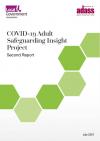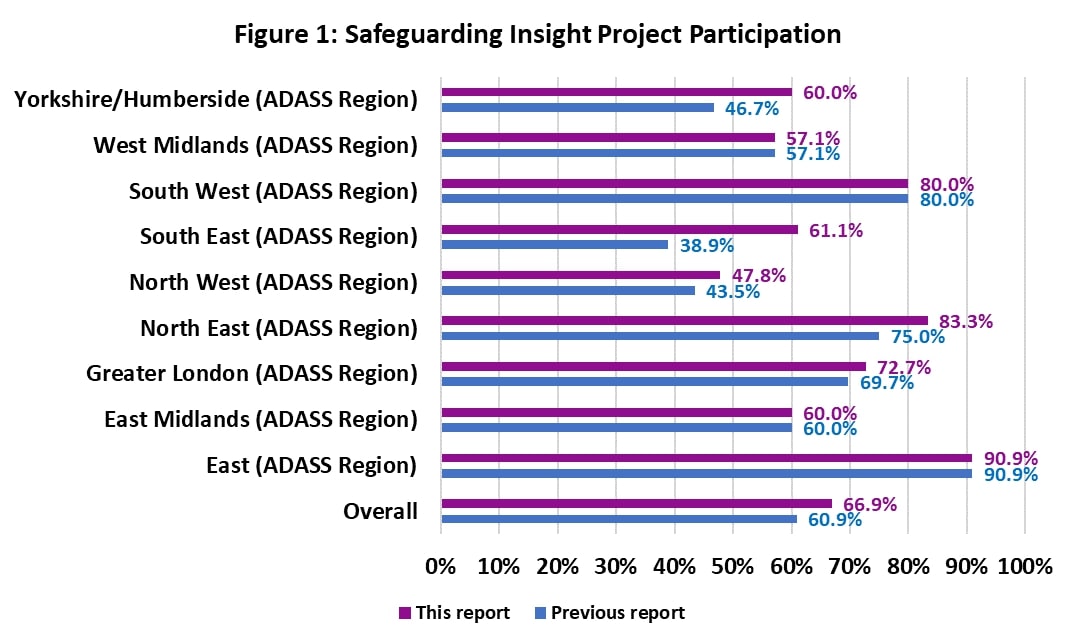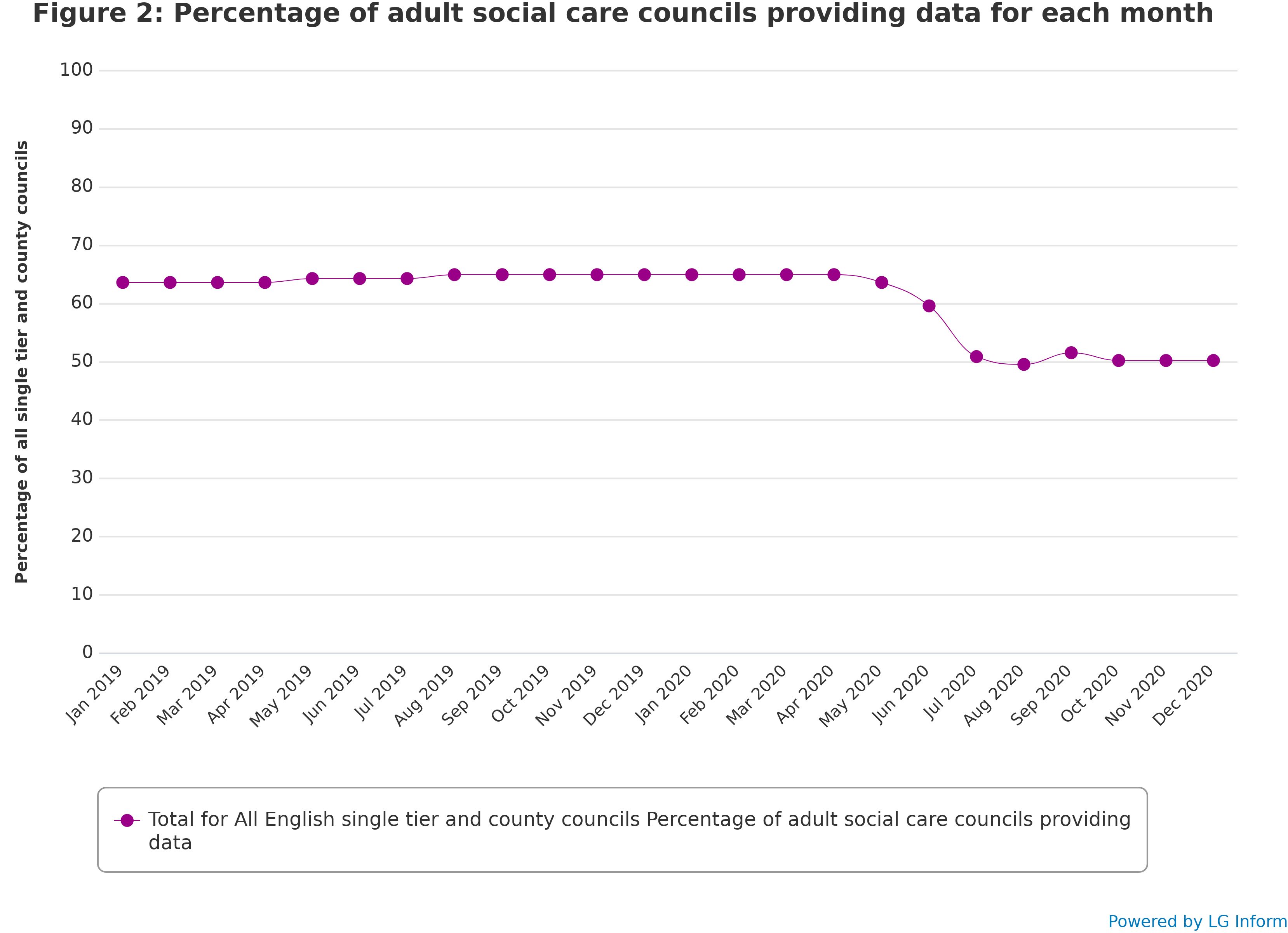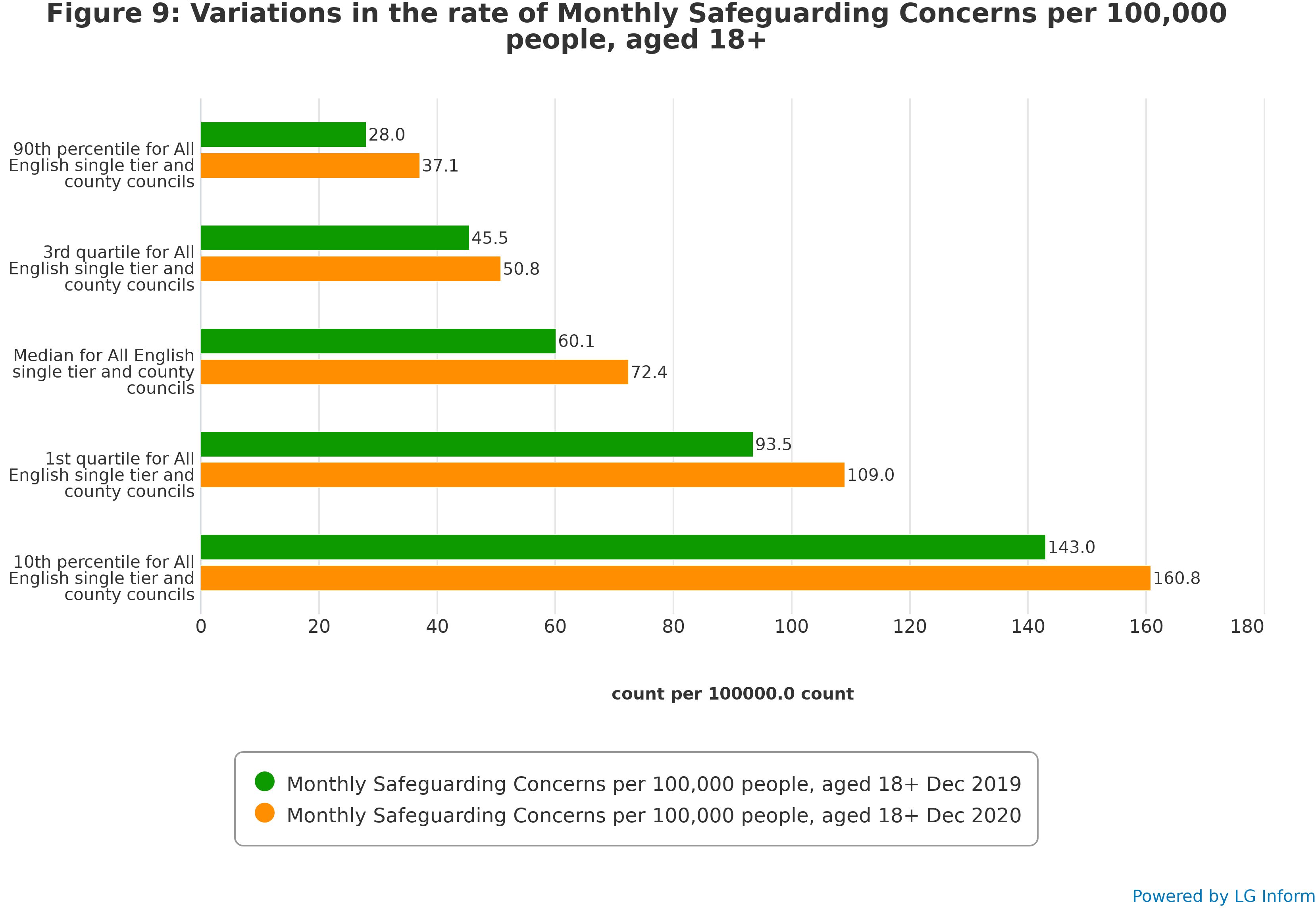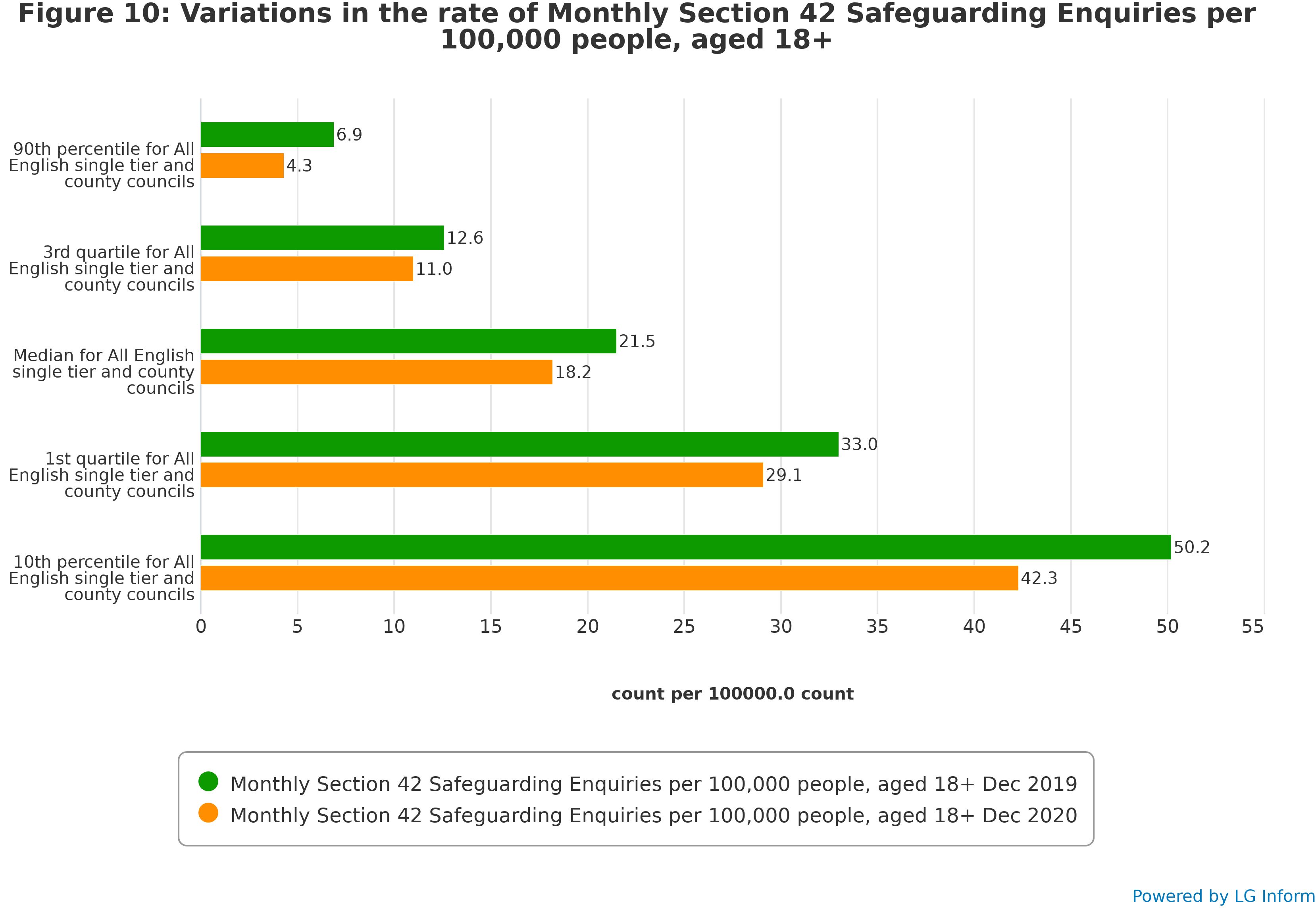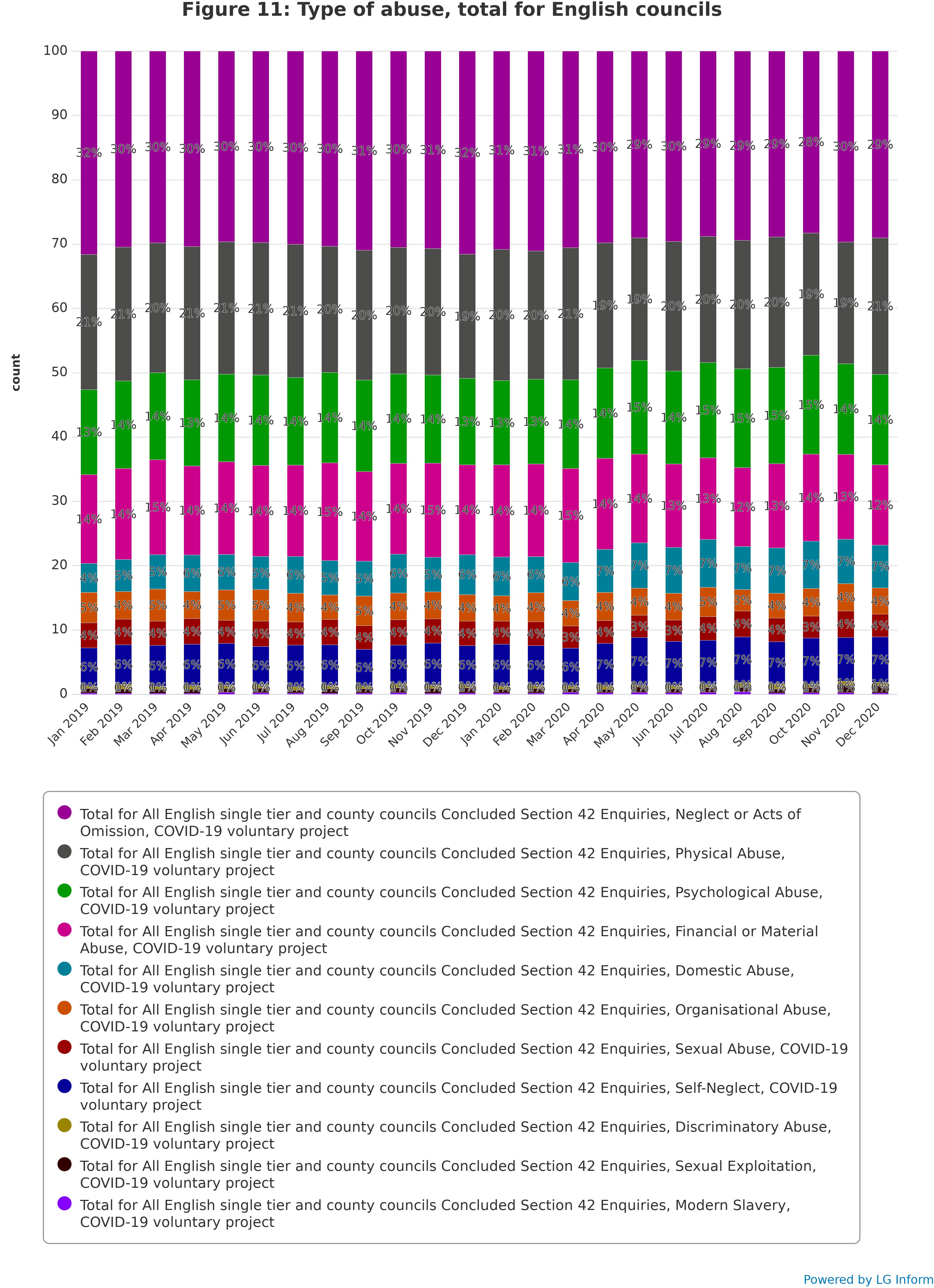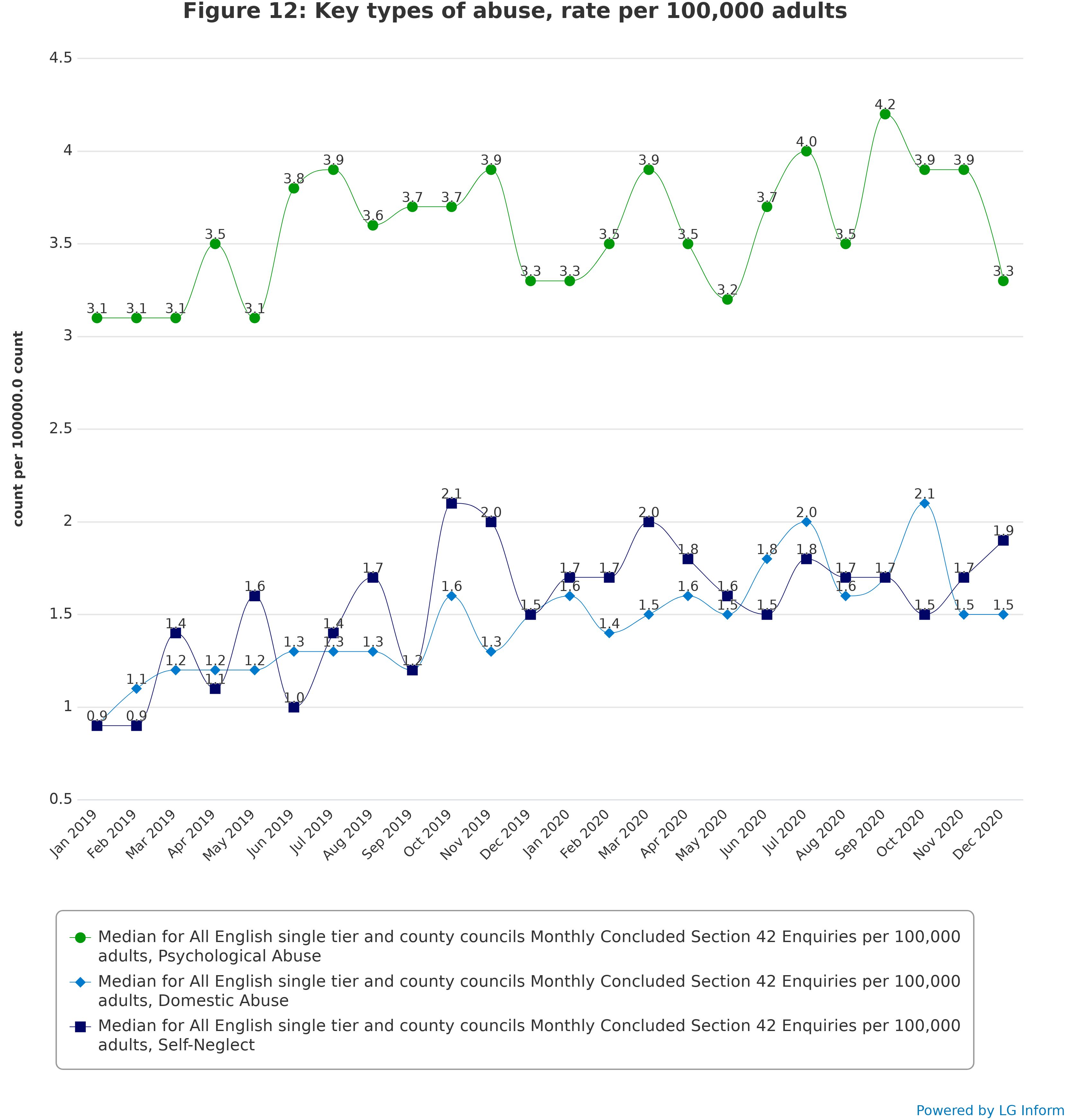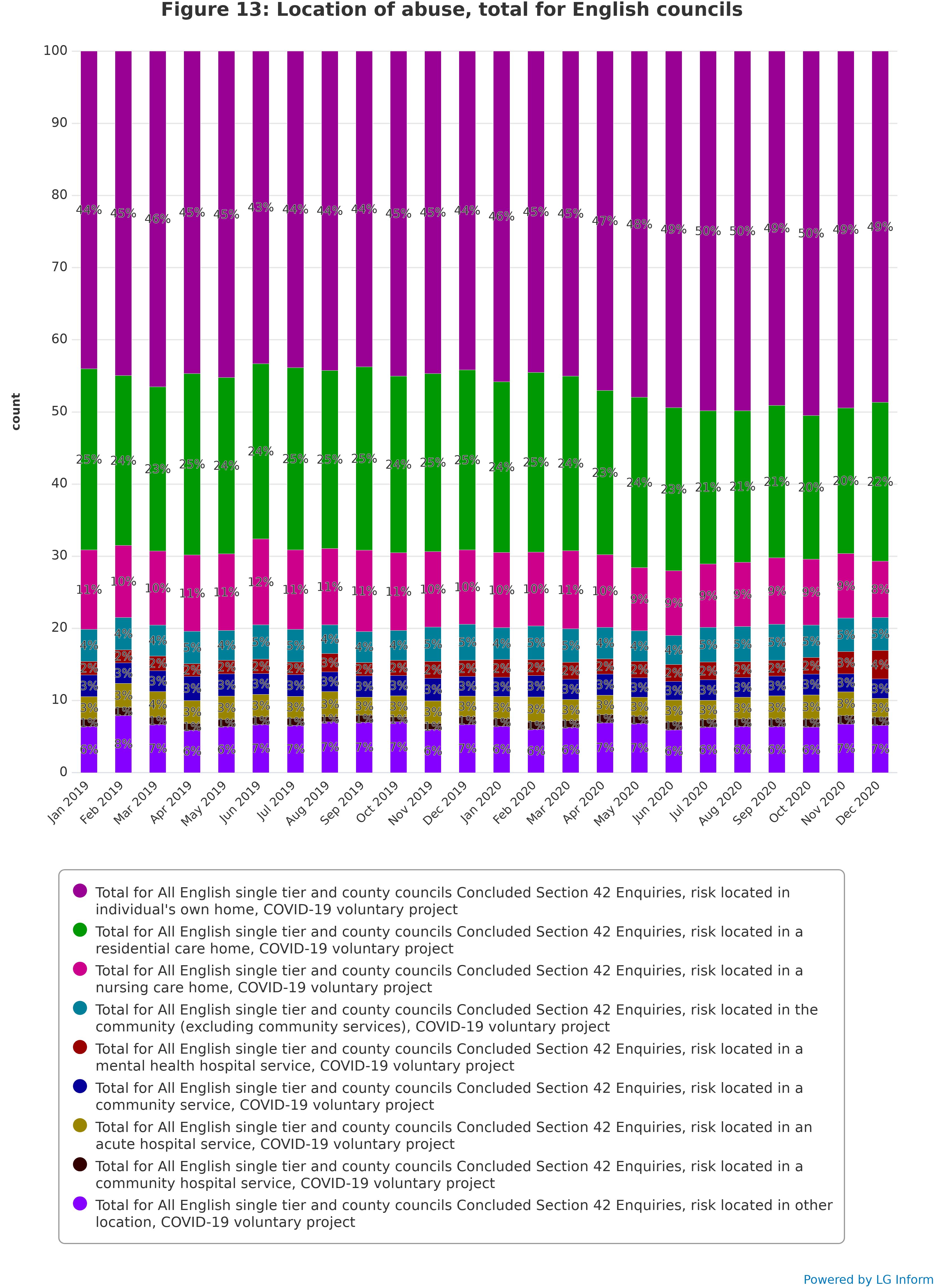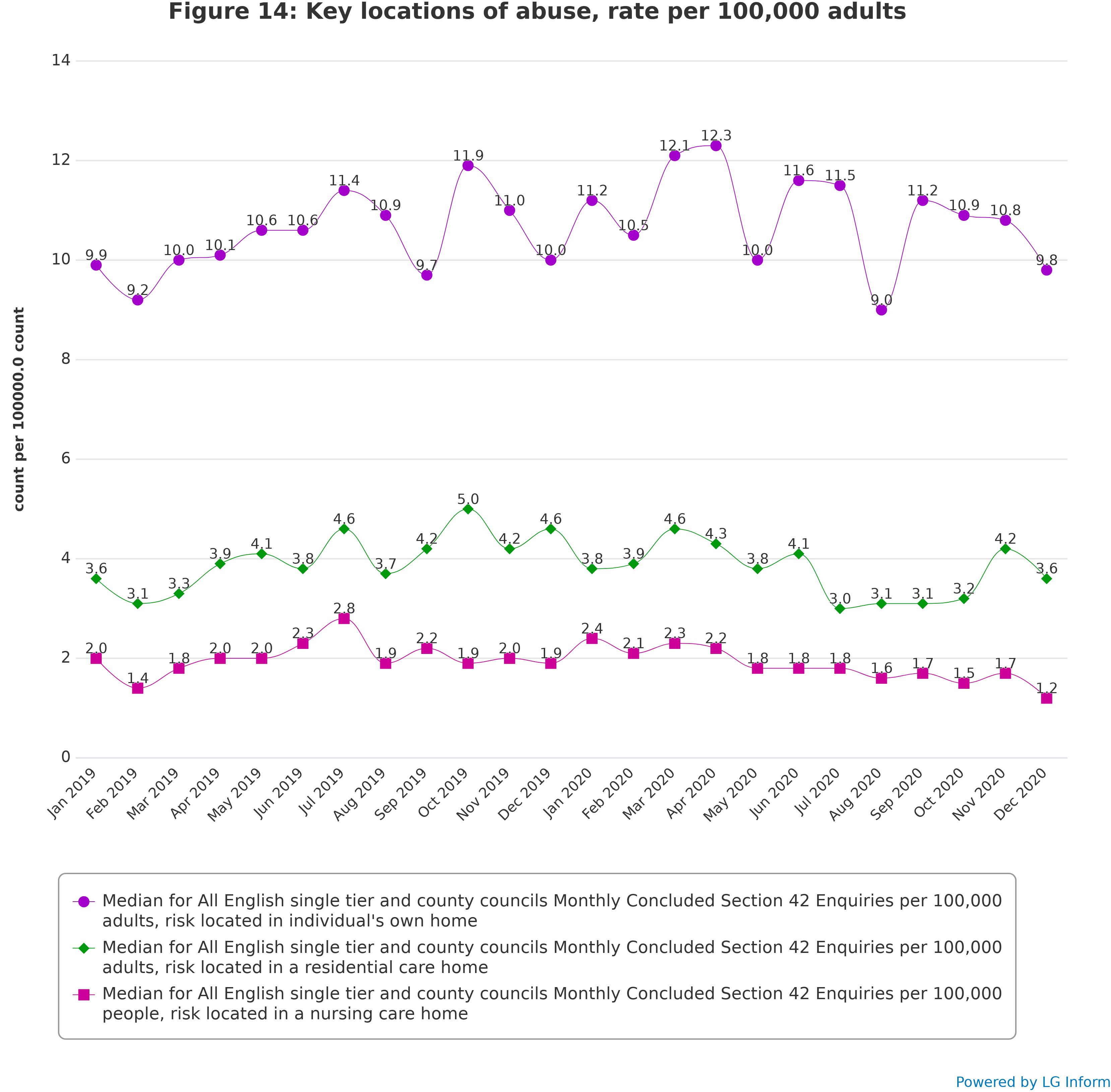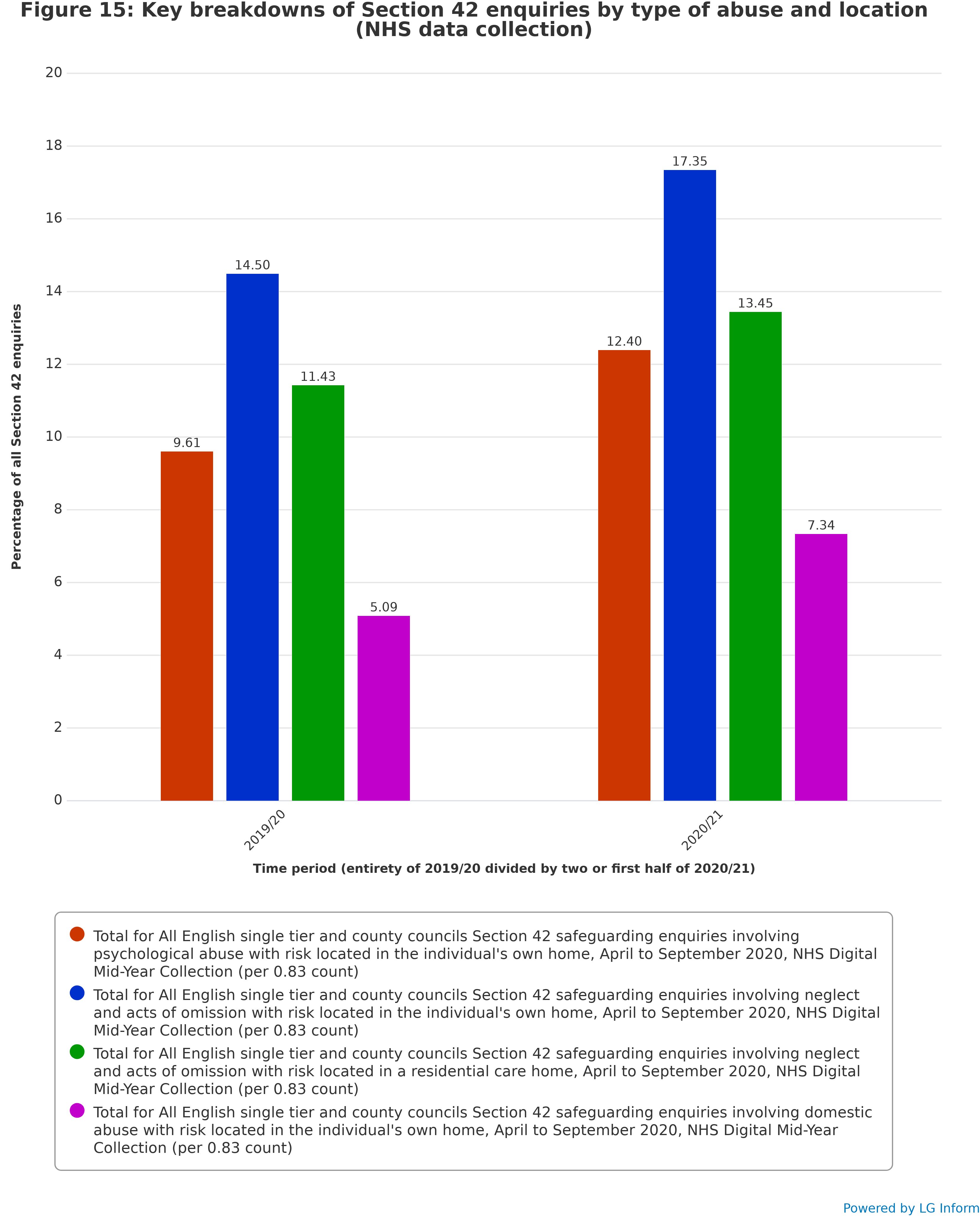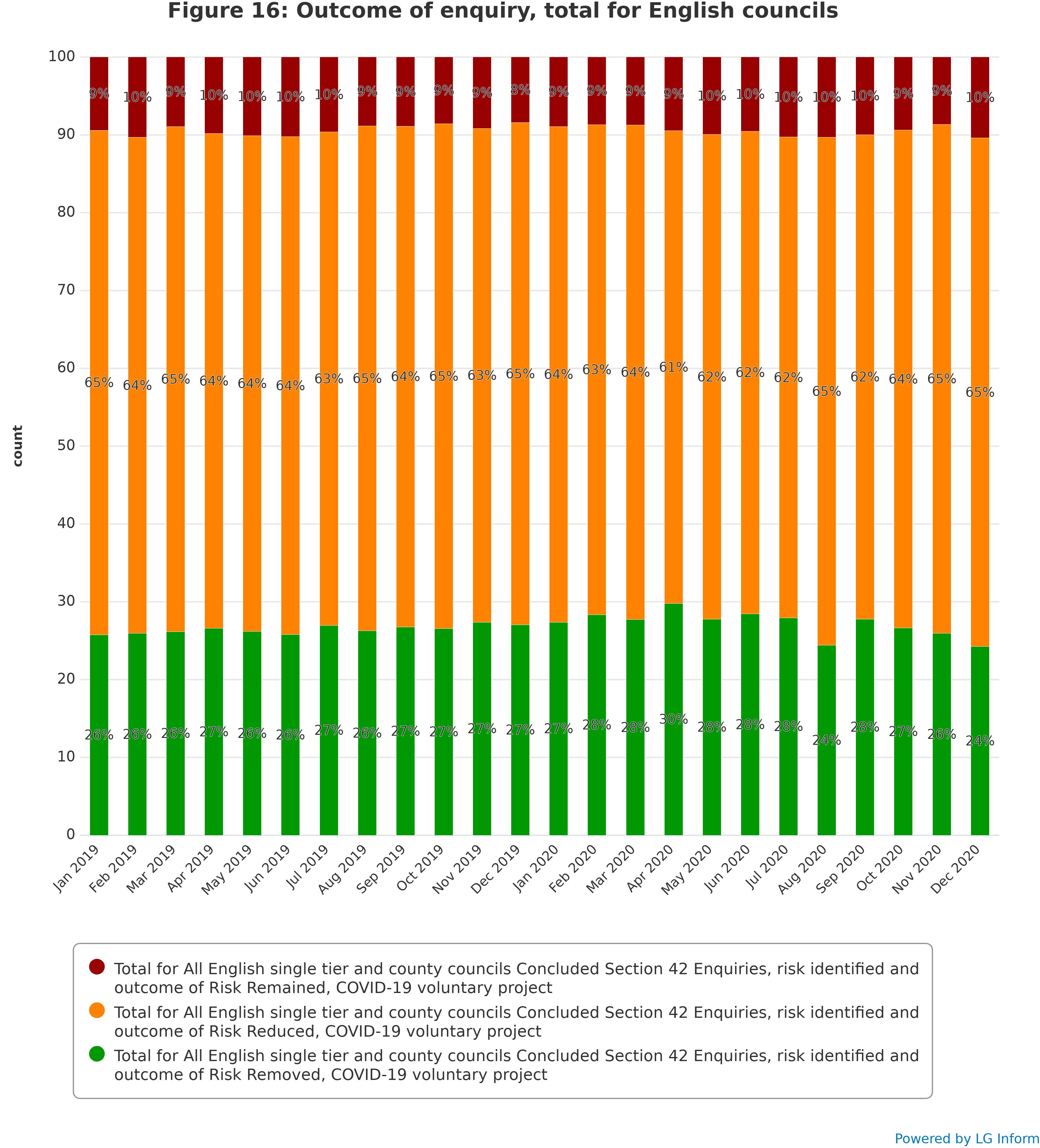COVID-19 related issues
Councils highlighted safeguarding referrals that were COVID-19 specific, which included: the risk and spread of the virus in care homes, particularly if residents or staff were COVID positive and continued to mix with others; support being declined by people concerned about possible transmission of COVID-19; self-neglect due to concerns about COVID; increased referrals about People in Positions of Trust not following COVID-19 guidance; and local approaches to being able or unable to enter residential settings. Councils, as highlighted in the first insight project report, identified how in the early days of lockdown, emergency service safeguarding referrals increased due to lack of personal protective equipment and concerns about alleged unsafe practice, ie care home staff not wearing personal protective equipment. These also included ‘anxiety driven’ referrals from the increased community contact with shielded and vulnerable residents, particularly regarding self-neglect, although these mostly did not meet the criteria for safeguarding enquiries. Increases in COVID-19 based scams were reported.
Some councils reported that some adults, who were self-isolating or clinically vulnerable, refused access to visiting social care or health staff due to fears of catching COVID-19. It was reported that practitioners often heard information second-hand, which created further distance from the adult who was at the centre of the safeguarding concern. Advocacy services expressed concerns about how personal protective equipment (PPE), particularly masks, creating a barrier to communication between advocate and the adult, particularly where their mental capacity was fluctuating or was borderline.
Safeguarding in regulated services, including care homes
Whistleblowing
Three (of 31) councils mentioned increased levels of whistleblowing regarding care homes and home care services, which reported on people who were not adhering to COVID-19 rules, or issues within care homes such as not having personal protection equipment and inadequate staffing levels. There were also whistleblowing cases regarding hospital settings. Councils described how these cases of whistleblowing required time to unpick as they would often be referring to several different issues, not
only about safeguarding.
Safeguarding in care homes – referrals of concerns
Councils recognised the increased pressure on care homes during the pandemic. The qualitative data describes a very mixed picture of whether adult social care saw an increase, decrease or a plateauing of safeguarding concerns during the lockdown periods. Whilst 48 per cent of councils, who shared their qualitative data, disclosed experiencing increased concerns received during lockdowns, 32 per cent saw decreases and 13 per cent saw broadly the same number. Even within those reporting an increase there were great levels of variance; whilst some saw only ‘slight increases’ others experienced 10 per cent increases in reporting. Further, a council may report seeing a decrease during one lockdown, only to experience expected levels or increase of referrals in subsequent lockdowns and the reverse was also true. For one council they saw increased referrals with a doubling of Section 42 (ii) enquiries for care homes in the lockdown period. Councils identified the following reasons for the increase in safeguarding concerns regarding care homes:
- close monitoring and engagement with the market and providers
- anxiety expressed by care homes around transmission of COVID-19
- low numbers of staff, which caused acts of omission
- increased medical errors
- agency staff unfamiliar with adults they are supporting thus resulting in increased referrals
- confusion over government advice causing providers to “appear to be acting in a neglectful manner”
- increase in incidents between people with learning disabilities who are resident in care homes
- increase in referrals relating to pressure area care and pressure injuries
- increase in referrals where deteriorating health conditions have not been recognised or escalated appropriately
- not wearing or inappropriate use of PPE.
For those councils who experienced decreased rates of safeguarding concerns, the majority said that they saw a correlation with the reduction in adult social care, health and other professionals making regular visits into care home. This meant that visual observations of care home environments and staff practices within the homes were not noted resulting in less reporting of safeguarding concerns. A minority noted that care homes were often focussing on caring and managing outbreaks rather than safeguarding. One council mentioned that they had changed the criteria of what was considered eligible as a safeguarding concern leading to an enquiry, for example not automatically making “one-off medication errors” into a Section 42(ii) enquiry.
A further reported impact of the pandemic and the pressure on care homes was that this caused delays in accessing care homes to undertake safeguarding enquiries and actions. There was also delay reported in convening some safeguarding meetings.
A few councils mentioned of provider 'failure' where issues had become more frequent and intense with the additional weight of the pandemic on top of prior weakness in a provider.
Councils reported that adult social care experienced significant increases in contact from care home providers seeking information and advice. This meant that services were put under increased pressure to provide preventative and reassurance work from social work teams, quality assurance teams, commissioning teams, public health teams and other joint initiatives with health services. These provided a range of support and interventions for care homes to be reassured and supported through the pandemic and protect their residents.
Prevention, innovation, and proactive approaches working with care homes
One of the proactive approaches taken to improve the monitoring and support of care provision mentioned by the majority of councils was the increase of multi-agency meetings to support providers face the challenges of the pandemic: 68 per cent of councils made explicit reference to improved multi-agency working. This included meetings with Clinical Commissioning Groups (CCGs), quality assurance, adult social care, safeguarding teams, general practitioners, public health, and commissioning, who would meet daily or weekly to compile intelligence, which was analysed to ensure a responsive approach to any emerging areas of concern, including safeguarding risks. These approaches were able to monitor emerging themes such as supply and use of personal protection equipment, reporting and management of COVID-19 outbreaks, deaths in care home, staffing capacity and capability, agency staff use and incident/safeguarding reporting. This enabled councils and their partners to make timely interventions to support care homes or escalate any concerns. Councils described commissioning teams holding weekly group calls with care homes, creating peer support for providers with the aim of resolving common issues, and councils and their partners being able to respond to issues as they emerged.
Councils also reported carrying out remote and verbal engagement with care homes, on occasion this required daily communications, to obtain COVID-19 updates and offer support and assistance as required. Discussions with care homes also enabled them to highlight any specific concerns unrelated to COVID-19. The involvement of commissioning, quality and improvement teams to work with care homes who had an outbreak or single cases of COVID-19 enabled more detailed conversations and actions by officers to gather information on the COVID-19 status of the care settings and identify any emerging risks in care homes. Risks could then be escalated to multi agency meetings where strategies were explored to find potential solutions whether it required guidance, additional guidance and/or additional actions.
A few councils mentioned conducting virtual care homes visits. One council described how they made 188 virtual visits during the nine-months between March and December 2020. These visits resulted in the identifying further support needs which adult social care services were able to resolve or manage.
Carers and safeguarding
The Insight Project was interested in exploring the impact of COVID-19 and lockdown on the experience of carers during the pandemic. 29 councils responded to this question. The interest stemmed from the increased levels of unpaid carers, which Carers UK estimates was an increase of 4.5 million people who began to provide unpaid care since the COVID-19 pandemic. This represents nearly a 50 per cent increase in the number of unpaid carers since the pandemic began. Studies by Carers UK and Age UK have revealed how carers’ mental health, physical health and employment opportunities can be compromised by the impact of caring.
Of the respondent councils 79 per cent described unpaid friend and family carers as experiencing increased “pressure”, “stress”, “isolation”, “frustration”, “exhaustion”, “impact on their mental health” and “burnout” due to the closure of day services, reduced care and support services, which meant increased number of hours caring. There was also some mention of increased behavioural issues and mental health issues for the adult with care and support needs, due to living within a COVID-19 pandemic situation. This was further exacerbated during the winter months where there was a reduced ability to meet safely outside or meet people outside of their household or ‘support bubble’. One council described the impact on unpaid carers as “intolerable” where carers were caring without a break, in addition to working from home and childcare, which had negative mental health impacts on both the carer and the person being cared for. Increased stress levels and isolation, without formal or informal networks of support were reported, and for some this meant increased levels of domestic abuse. Reporting included risks of carer breakdown, due to feelings of ‘being unable to continue in the caring role’. Councils reported breakdowns in care packages due to carer stress resulting from limited access to community services, care support reduced or withdrawn, and the fear and anxiety about the transmission of COVID-19.
Approaches to working with carers
Some councils identified that increased pressures on carers were not necessarily translating into increased levels of safeguarding concerns – there was reporting of either delays in reporting safeguarding concerns or no reports at all. One council described how they had over 100 referrals made to them, where they were able to prevent carer breakdown, and mitigate safeguarding risks. They also had experienced an increased level of referrals regarding young carer referrals. This council commissioned a carers service, which received around 40 referrals since March and provided a “take a break” service, which was an alternative to day centre support as day centres were unable to operate at full capacity. Further this provided support for those carers who were reluctant to send cared-for person to the centre for respite, fearing infection, because of the pandemic. A couple of councils observed that they were more proactive, and would repeatedly offer support to carers, and not assume that they ‘were fine’ as they were not asking for help.
Changes to ways of working impacting on safeguarding practice
The COVID-19 pandemic and lockdowns have dramatically affected the ways in which safeguarding is practiced and this section summarises the insight provided by participating councils covering both the challenges and innovative responses to them.
Working flexibly and adapting to new ways of partnership working
During the pandemic councils were facing additional workloads on top of their ‘business as usual’ work. As described in Part 1 of this report, the work with shielded and clinically vulnerable residents, community outreach and emergency service contact led to increases in reporting of safeguarding concerns. Many councils described an increase of reporting “low-level harm” or safeguarding concerns that did not meet the Section 42(ii) criteria’ (depending on reporting methods). One council described that they considered this a “positive” sign that demonstrated increased partnership working, showed a great level of transparency and a more proactive approach to support. This partnership working could enable early identification of themes and trends to develop proactive approaches to counter issues as they arose. Reporting systems were also put in place to ensure learning had been embedded and sustained change. Conversely some councils reported that adults were not accessing community resources and as a result seeing they was a reduction of community-based safeguarding concerns.
Reduced face-to-face working
Councils reported that the pandemic meant that there was less face-to-face interaction in safeguarding activity to reduce risks of transmission: for some this meant an approach to stop almost all ‘in person’ interaction; for others there was more discretion allowed with time sensitive and/or more urgent safeguarding concerns being dealt with in person. There were varied approaches with some councils expressing caution regarding over-reliance on technology over in personal contact..
Whilst Making Safeguarding Personal has always remained central to all safeguarding practice with adults, Councils reported that it was more difficult to enable this approach during the lockdown periods and has required careful planning to deliver. There were concerns that reduced numbers of face-to-face assessments were resulting in less opportunity for safeguarding disclosures. There were also concerns that the person talking with a carer present could be a barrier to reporting or disclosing abuse. Similarly, concerns were expressed about reduced access to care homes, due to risk of COVID-19 transmission, meant that fewer safeguarding concerns were disclosed.
IT and video conferencing: pros and cons
Video conferencing, most commonly in the form of Zoom or Teams, has emerged as one of the most powerful and constructive tools to support practitioners to navigate through the pandemic, to maintain communication and practice. This has enabled the creation of virtual multi-agency/partnership working. Councils reported that partners were meeting on daily and/or weekly basis, most commonly through these video conferencing platforms. Most councils spoke of embracing this new way of working and 68 per cent of councils (21 of 31) explicitly mentioned improved collaborative working with partners during the pandemic. More frequent and regular meetings have been able to be set up than before the pandemic and these are reported as better attended then previously. Councils reported forming new partnerships, increased networking, and regular engagement with a wider group of providers. Whilst the overall picture was increased positive relationships with partners during the pandemic, there were also strained relationships reported, with health colleagues. These were considered to be due to different priorities, for example pressures to discharge people from hospital; competing for PPE; prioritising COVID-19 vaccinations for health staff rather than social care staff. Relevant to safeguarding activity, there were reports that in some cases information from health partners was shared in a less timely manner when safeguarding enquires were being carried out due to pressures on health services.
Councils reported that virtual meetings ensured that safeguarding responsibilities and duties could be maintained at a Safeguarding Adults Board (SAB) level. There were examples cited of Heads of Adult Safeguarding having weekly virtual meetings with the Chair of their SABs. Councils reported that these SAB meetings were sustained as these were arranged virtually.
Some councils reported that the number of meetings increased for collaborative decision making by professionals, who were unable to physically meet with adults and so were more reliant on each other to make sense of a situation and to support each other and the person they were working with. Other councils spoke of arranging virtual monthly meetings with all safeguarding adult operational leads including adult social care, police, hospital, CCG, housing, and their mental health trust, which:
... enabled any trends or issues to be identified and addressed. Following the first lockdown, the monthly meetings with the operational leads continues as partners have found them to be helpful. This has embedded a transparent, supportive strategy. We have also seen much closer partnership working across children’s and adults’ services, especially with the complex safeguarding hub and aftercare."
Other councils described how they were having more virtual safeguarding enquiry meetings and risk framework meetings. It was reported that the virtual media also enabled adults to engage in meetings:
They had the power to have cameras off and the ability to participate discreetly in the background, which allows people to be a part of the proceedings in a way that suits them better than being physically present."
Some councils described how this way of communication could also form part of an offer within a suite of options of how a person may choose to engage with the safeguarding process after COVID-19 restrictions ended. This also appeared to get greater engagement from practitioners as well in virtual meetings.
MS Teams has enabled and encouraged better involvement of practitioners and agencies in safeguarding enquiry meetings and risk framework meetings and this includes the police, probation and external housing providers."
Councils also noted that this change in using video conferencing did not suit all people, particularly some older people. Some people preferred to use of their phones rather than their computer video participation. However, even the more conventional phone call proved to be a valuable participatory option during the pandemic. Use of video conferencing has meant that meetings could be set up swiftly and it ‘sharpened the communication skills’ of practitioners over the phone with adults when discussing their concerns.
The negative impact of using virtual platforms/video technology/technology was also commented on by participants. 22 of 30 councils expressed the loss of face-to-face as being a challenge and reported on the difficulties of substituting technology in place of face-to-face contact. For example, when conducting a safeguarding enquiry process in a care home, where practitioners had limited access, using technology to talk to people or gain information from staff was problematic when it did not always work well, or if the person was reluctant to speak in front of care home staff. In these situations, some councils reported of agreeing ‘in-person’ meetings on an exceptional basis to obtain complete and accurate information. Whilst technology was invaluable in the pandemic to support practice, it was not always effective.
One council highlighted inequity of access to information technology where internet provision was not always available, for example for adults in supported living arrangements, or where the on-site internet was only available for staff use and so the advantages of new technological initiatives could not be fully realised by these adults. However, in these cases councils ensured that there were alternative and appropriate provision for people to communicate to practitioners by other means, for example the phone.
Councils also expressed some negative consequences of video conferencing, such as adults being able to disengage by switching off their connection. There was also a negative impact reported on Making Safeguarding Persona as some people were less likely to participate in video conferences. There was recognition that video conferencing could change the outcome and the conversation. In some cases, the adult with care and support needs required support to access or use the virtual platforms. Unfortunately, this could increase barriers to engagement, if the safeguarding disclosure to a practitioner was about the technological enabler, or they were the potential source of a safeguarding concern.

